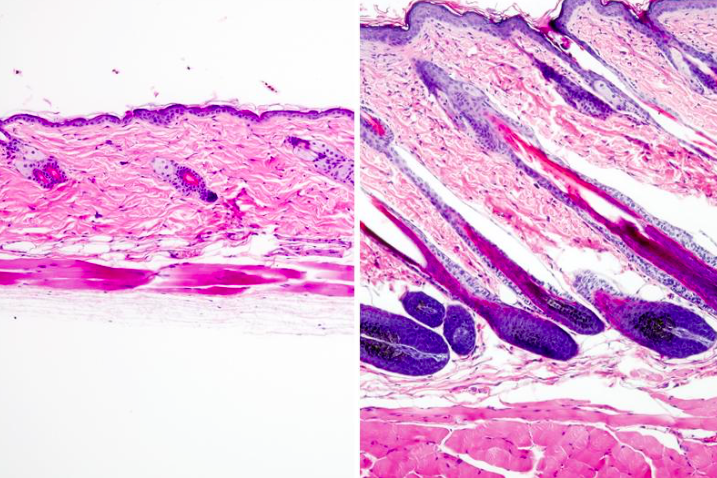
August 15, 2017
 Source/UCLA Broad Stem Cell Center/Nature Cell Biology
Source/UCLA Broad Stem Cell Center/Nature Cell Biology
Untreated mouse skin showing no hair growth (left) compared to mouse skin treated with the drug UK5099 (right) showing hair growth.
The ever-elusive cure for thinning hair, a concern that plagues both men and women, may have taken a taken a tentative step forward with the results of a new research study that focuses specifically on the role of follicle stem cells.
In new findings published in Nature Cell Biology, UCLA researchers revealed the discovery of a new way to activate hair regrowth by focusing on the unique metabolism of "quiescent" hair follicle stem cells. Although long-lived, these stem cells are normally inactive until the start of a new hair cycle, when they quickly spur regrowth in the anagen phase.
The UCLA study authors explain how the metabolism of hair follicle stem cells — the way they divide, produce energy and respond to their environment — differs from other cells of the skin:
As hair follicle stem cells consume the nutrient glucose — a form of sugar — from the bloodstream, they process the glucose to eventually produce a metabolite called pyruvate. The cells then can either send pyruvate to their mitochondria — the part of the cell that creates energy — or can convert pyruvate into another metabolite called lactate.
Converting pyruvate into lactate could be the key to promoting more active follicles.
“Our observations about hair follicle stem cell metabolism prompted us to examine whether genetically diminishing the entry of pyruvate into the mitochondria would force hair follicle stem cells to make more lactate, and if that would activate the cells and grow hair more quickly,” said Heather Christofk, an associate professor of biological chemistry and molecular and medical pharmacology.
In one test on mice, the researchers found that when they genetically blocked lactate production, hair follicle stem cell activation was prevented. A second test, completed in collaboration with the Rutter Lab at the University of Utah, found that genetically increasing lactate production in mice accelerated hair follicle stem cell activation and increased the overall hair cycle.
“Before this, no one knew that increasing or decreasing the lactate would have an effect on hair follicle stem cells,” said Lowry, a professor of molecular, cell and developmental biology. “Once we saw how altering lactate production in the mice influenced hair growth, it led us to look for potential drugs that could be applied to the skin and have the same effect.”
The research team identified two drugs, RCGD423 and UK5099, that each promoted lactate production when applied to the skin of mice. The first drug works by activating a cellular signaling pathway called JAK-stat, increasing lactate production and in turn the activation of hair follicle stem cells to stimulate hair growth. The second drug blocks pyruvate from entering the mitochondria, forcing the production of lactate in the hair follicle stem cells and accelerating hair growth in mice.
Both experimental drugs are covered by provisional patent applications filed by the UCLA Technology Development Group on behalf of UC Regents. They have been used in preclinical tests only and have not been tested in humans or approved by the Food & Drug Administration.
“Through this study, we gained a lot of interesting insight into new ways to activate stem cells,” said Aimee Flores, a predoctoral trainee in Lowry’s lab and first author of the study. “The idea of using drugs to stimulate hair growth through hair follicle stem cells is very promising given how many millions of people, both men and women, deal with hair loss. I think we’ve only just begun to understand the critical role metabolism plays in hair growth and stem cells in general.”